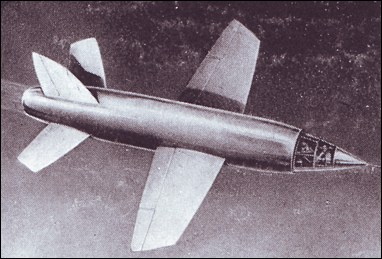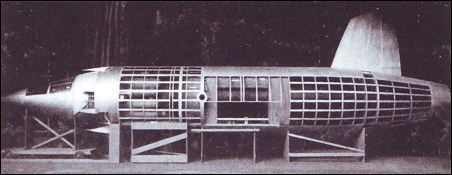 |
Miles M.521946 |  |
| RESEARCH AIRCRAFT | Virtual Aircraft Museum / United Kingdom / Miles |
 |
The Miles E.24/43, or M.52, was an extremely advanced project on which Miles Aircraft Ltd worked for three years until a high-level decision suspended further work. It was a decision which may well rank as one of the major tragedies of British aviation. The Miles company began work on the M.52 in 1943, at a time when knowledge of high-speed aerodynamics was strictly limited. As the project was masked in secrecy, Miles set up its own foundry for the production of the necessary metal components and also built a high-speed wind tunnel. The design that gradually evolved featured a bullet-like fuselage of circular section, 1.5m in diameter, constructed of high-tensile steel with an alloy covering. The powerplant, a Power Jets W.2/700, was centrally mounted and fed by an annular air intake, the cockpit forming a centre cone. The whole cockpit cone, in which the pilot sat semi-reclined, could be detached in an emergency by firing small cordite charges; the pilot would then bale out normally when the capsule reached a lower altitude. The M.52 was fitted with biconvex section wings, mounted at mid-point on the fuselage. A full-scale wooden mock-up of this unique high-speed wing design was built and tested on a Miles Falcon light aircraft in 1944. As design work progressed, various refinements were incorporated. Split flaps were fitted, together with an all-moving tailplane. The addition of rudimentary afterburners in the form of combustion cans situated at the rear of the engine duct was calculated to produce much greater thrust at supersonic speed. The undercarriage's position presented some headaches; the very thin wing section meant that the wheels had to be positioned to retract into the fuselage, a narrow-track arrangement which might cause landing problems. Detailed design work on the M.52 was 90 per cent complete by the beginning of 1946, and the jigs were ready for the assembly of three planned prototypes. No snags were envisaged in construction, and it was expected that the first M.52 would fly within six to eight months. Then, in February 1946, quite without warning, F.G.Miles received word from the Director General of Scientific Research at the Ministry of Aircraft Production, Sir Ben Lockspeiser, that all work on the M.52 project was to cease at once. Secrecy surrounded the cancellation of the M.52, just as it had surrounded its design, and it was not until September 1946 that the British public were made aware that their aircraft industry had been within sight of flying the world's first supersonic aircraft, only to have the chance snatched away. The stated reason behind the decision to cancel the M.52 was that it had already been decided, early in 1946, to carry out a supersonic research programme with the aid of unmanned models developed by Vickers Ltd. The department responsible was headed by Dr Barnes Wallis, designer of the special mines which had breached the Ruhr dams in 1943. Between May 1947 and October 1948 eight rocket-powered models were launched, only three of which were successful. In each failure (apart from the first attempted launch when the Mosquito launch aircraft got out of control in cloud and the model broke away) it was the rocket motor that failed, not the airframe. The irony was that most of the models were based on the design of the M.52, and the double irony was that, in the light of current knowledge, the full-size M.52 would almost certainly have been a success. Meanwhile, only a year after the M.52's cancellation was made public, Major Charles Yeager, US Air Force, had made history's first supersonic flight in the rocket-powered Bell X-1 research aircraft. Robert Jackson "The Encyclopedia of Aircraft", 2004
|  COMPANY PROFILE | |||||||||||||||||||||||||||||||||||||||
 |

|

